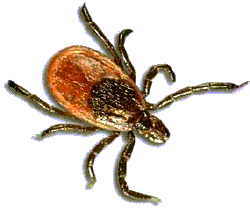|
Three
different infections can be transmitted by the Ixodes
tick, but specific information regarding the types of
symptoms and their duration before presentation has not
been well-described. In addition, although coinfection
with two or perhaps three of these pathogens, Borrelia
burgdorferi, Babesia microti or the agent of
human granulocytic ehrlichiosis (HGE), has been described,
it is not known whether clinical manifestations can help
distinguish infection between single vs. concurrent infection.
The
authors evaluated 192 patients with confirmed infection
of a total of 310 who were originally seen for suspected
tick-borne illness. Patients were residents of Block Island,
RI, Nantucket, MA and southeastern Connecticut and completed
a standardized questionnaire at the time of clinical presentation.
Diagnosis of Lyme disease and babesiosis was based on
established criteria; diagnosis of HGE required clinical
symptoms consistent with HGE and anti-HGE antibody seroconversion
with or without identification of morulae on thin blood
smear or DNA evidence by specific PCR testing.
The
authors found that 39% of their patients presented with
concurrent infection; 81% had coinfection with Lyme disease
and babesiosis. The majority of patients with Lyme disease
had erythema migrans, and none of the patients with one
of the other infections had a rash. The presence of
flu-like symptoms without a rash was more suggestive of
Lyme disease with a concurrent infection than of Lyme
disease alone.
When
evaluating 17 symptoms, individually and as a group, the
triad of fever, chills and headache was seen in 44% of
patients with Lyme disease coinfection compared with only
13% with Lyme disease alone. Based on this sample findings
of disseminated Lyme disease (i.e. disseminated erythema
migrans rash, arthritis, Bell's palsy, meningitis or carditis)
were equally distributed between patients with Lyme disease
alone and those with Lyme disease and concurrent infection,
suggesting that concurrent infection does not increase
the likelihood of acute dissemination of B. burgdorferi.
For patients who had Lyme disease as a coinfecting agent,
the presence of anemia and thrombocytopenia strongly suggested
concurrent babesiosis, whereas leukopenia was seen with
concurrent infection with HGE.
Comment
by Kevin A. Slavin, M.D., Hackensack, NJ:
In endemic areas of the Northeast and Midwest, Lyme disease,
babesiosis and HGE cause significant disease. Although
previous studies have attempted to discern the likelihood
of coinfection with two or more of these pathogens, this
is one of the first studies to specifically evaluate whether
concurrent infection can be determined based on clinical
presentation. However, one must note the relatively small
number of patients in each of the different disease group
classifications and the skewed distribution. For example
more patients had HGE and Lyme disease coinfection (seven)
than had HGE alone (three). This makes it difficult to
determine whether the differences noted by the authors
are the result of true differences between those with
single infection vs. those with coinfection.
Despite
the small numbers of the subgroups, some conclusions can
be drawn based on the findings of the larger groups. For
example the authors' findings do suggest that if Lyme
disease is diagnosed in a patient with flu-like symptoms
and no erythema migrans rash, the practitioner may want
to consider evaluation for concurrent infection. Of the
different laboratory tests a complete blood count appears
to be the most cost-effective method for screening for
concurrent infection because HGE and babesiosis both have
findings that were not seen in patients with Lyme disease
as a single infection. In addition if there is a high
index of suspicion for babesiosis or HGE, specific IgM
testing should be performed in conjunction with a second
specific method, such as PCR or microscopic examination
of the peripheral blood.
Because
coinfection with two or more pathogens can occur, the
ability to distinguish the presence of Lyme disease, babesiosis
or HGE based on clinical symptoms would be extremely useful
in clinical practice. This study does suggest that this
may be possible, but the overall small numbers preclude
the ability to extrapolate to specific groupings of concurrent
infections. A larger, more comprehensive study may be
required to clearly discern whether clinical presentation
alone can determine who should be evaluated for concurrent
infection.
Pubmed
abstract
|
